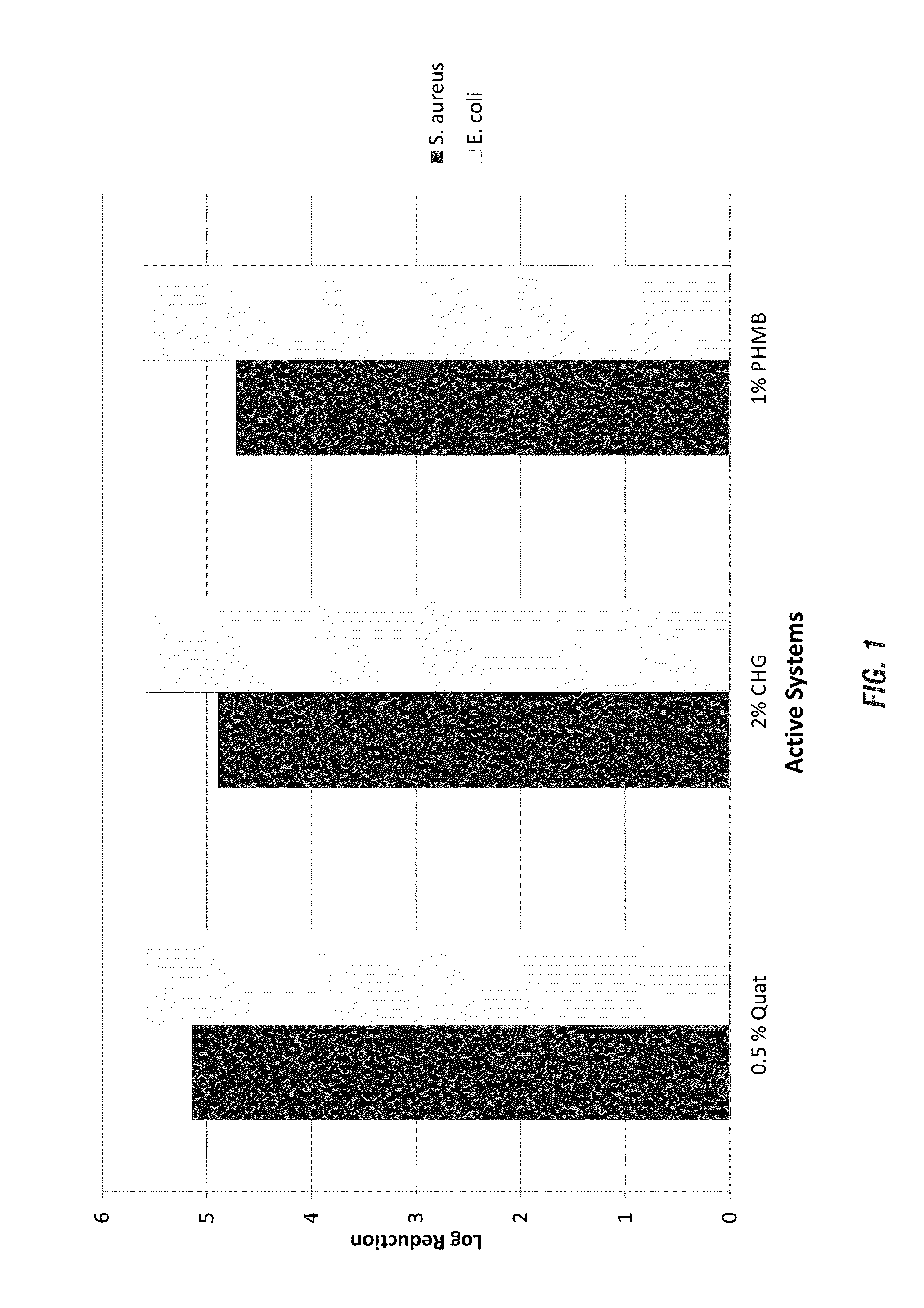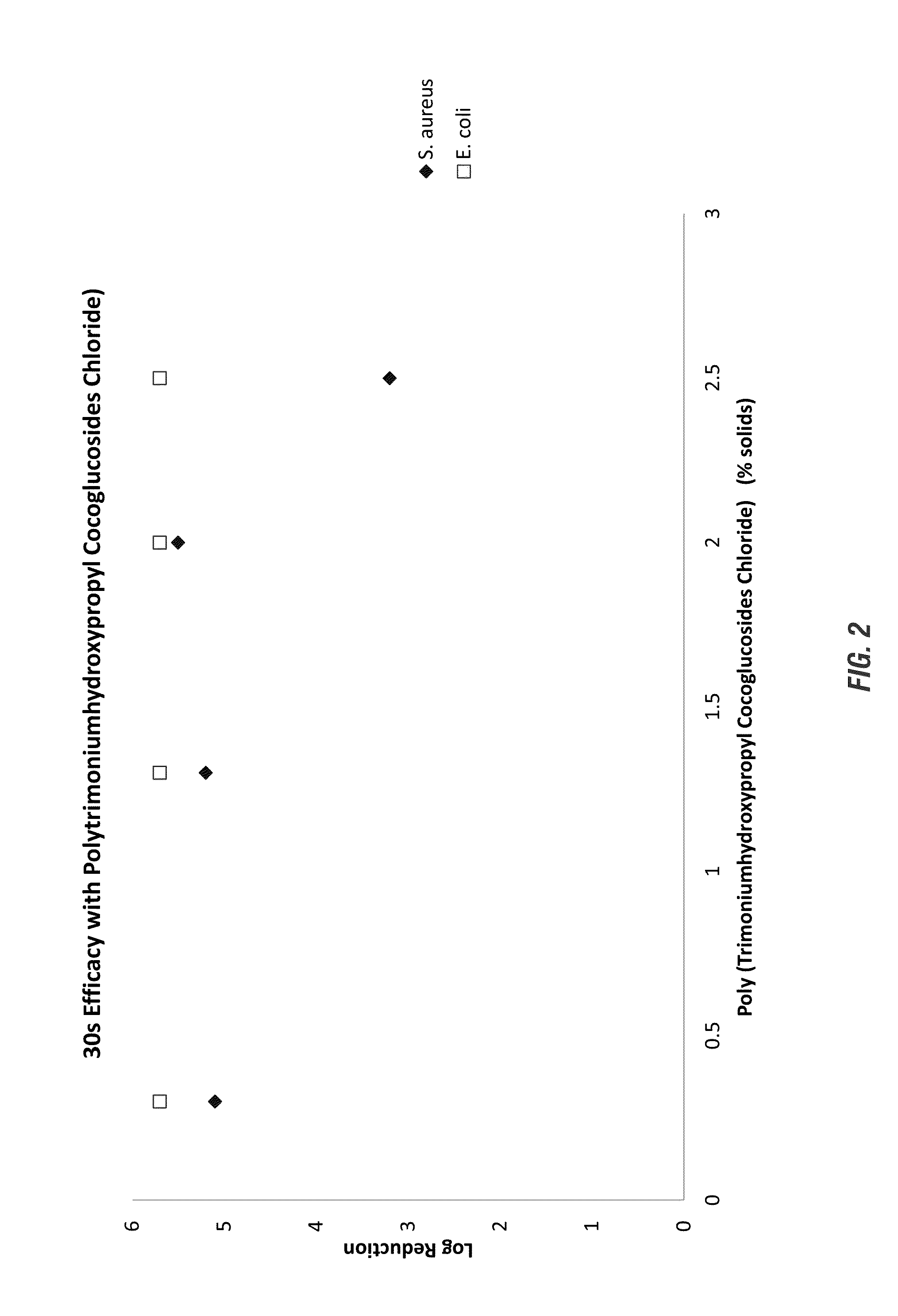Antimicrobial compositions containing cationic active ingredients
a technology of cationic active ingredients and compositions, applied in the field of antimicrobial compositions, can solve the problems of disfavored triclosan, and achieve the effects of rapid cidal efficacy, rapid cidal efficacy, and high foaming attributes
- Summary
- Abstract
- Description
- Claims
- Application Information
AI Technical Summary
Benefits of technology
Problems solved by technology
Method used
Image
Examples
example 1
[0147]The following Figures demonstrate efficacy data of the present antimicrobial composition, using various cationic active ingredients, quaternary sugar-derived surfactants and optional foam boosting surfactants.
[0148]Table 7 and FIG. 1 (Log Kill of Cationic Active Ingredients):
[0149]The following figures illustrate the efficacy following a 30 second exposure time of three different cationic active ingredients, specifically, 0.5% Quat (Benzalkonium Chloride), 2% CHG (Chlorhexidine Gluconate), and 1% PHMB (polyhexamethylene biguanide) in a representative surfactant system.
[0150]Table 7 illustrates the formulas for the three cationic active ingredient systems tested. Both the quaternary sugar-derived surfactant and foam boosting surfactant were held constant and only the cationic active ingredient was changed between the three tests performed. The results are illustrated in FIG. 1.
TABLE 7Active IngredientLevelSystemIngredients(% w / w)QuaternaryActive Ingredient0.5AmmoniumQuaternized...
example 2
Mackernium 007S—DADMAC / Acrylamide Copolymer (Rhodia)
Uniquat QAC50—Benzalkonium Chloride (Lonza)
[0174]Dissolvine 100S—Ethylenediamine Tetraacetic acid sodium salt (Akzo Nobel)
Barlox 12—N-Alkyl (C12-16) dimethyl amine oxide (Lonza)
Cola Lipid C—Cocamidopropyl PG dimonium chlorophosphate (Colonial Chemical)
PolySugaQuat TM8610P—Polyquaternium 77 (Colonial Chemical)
Glucam E20—Methyl Gluceth 20 (Lubrizol)
Cetiol HE—PEG-7 Glyceryl Cocoate (Cognis)
Ritasol SP 1005—PEG-12 Dimethicone (Rita Corporation)
Hest G-18-O—Glycereth-18 Ethylhexanoate (Global Seven)
Kathon CG—Methyl Isothiazolinone (DOW Chemical)
[0175]
TABLE 14ExampleExample#1#2USP Water74.473.7Acrylamide / DADMAC Copolymer0.60.59Benzalkonium Chloride, 50%2.52.4Tetrasodium Ethylenediaminetetraacetic acid,00.9940%Lauryl Dimethylamine Oxide, 30%21.821.6Lactic Acid0.690.69Total100100
TABLE 15Example#3USP Water56.91Acrylamide / DADMAC Copolymer0.48Benzalkonium Chloride, 50%1.98Tetrasodium Ethylenediaminetetraacetic acid, 40%0.80Lauryl Dimethylamine ...
PUM
| Property | Measurement | Unit |
|---|---|---|
| contact time | aaaaa | aaaaa |
| contact time | aaaaa | aaaaa |
| stability constant | aaaaa | aaaaa |
Abstract
Description
Claims
Application Information
 Login to View More
Login to View More - R&D
- Intellectual Property
- Life Sciences
- Materials
- Tech Scout
- Unparalleled Data Quality
- Higher Quality Content
- 60% Fewer Hallucinations
Browse by: Latest US Patents, China's latest patents, Technical Efficacy Thesaurus, Application Domain, Technology Topic, Popular Technical Reports.
© 2025 PatSnap. All rights reserved.Legal|Privacy policy|Modern Slavery Act Transparency Statement|Sitemap|About US| Contact US: help@patsnap.com



